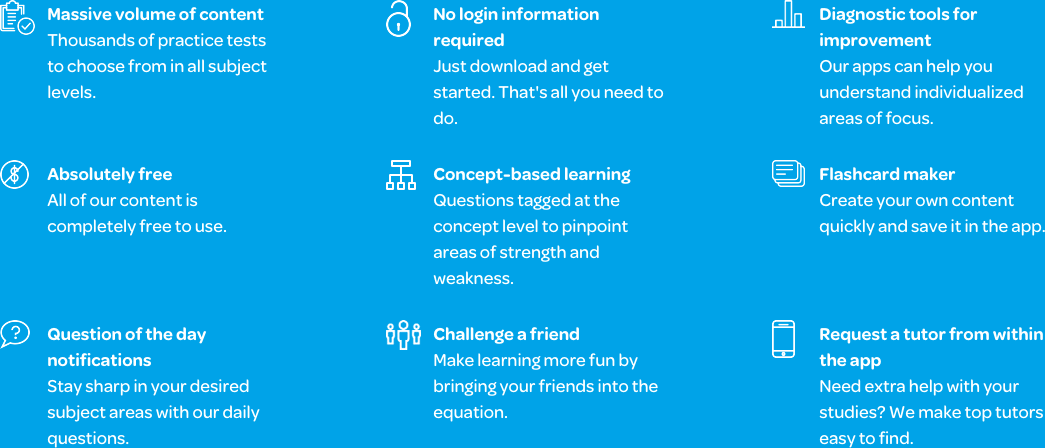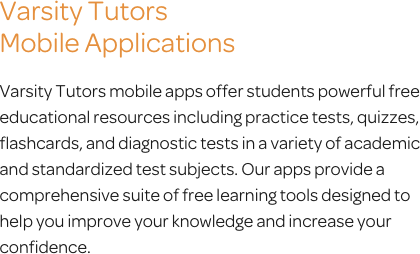The Varsity Tutors ISEE Mobile App
Students entering grades 5 through 12 who are applying to private schools across the country will likely have to take the Independent School Entrance Exam, or ISEE. If this is your student, they will want to get the free Varsity Tutors ISEE Prep app for iPhone, iPad, and Android to help pave the way.
The ISEE Prep app gives your student several tools that can be used to drill down on the topics covered by the test. The prep material in the app is professionally written for each of the various grade levels of the ISEE. Simply pick your level based on your child’s grade and customize the app to meet their study needs.
The ISEE splits students into three different grade-based levels, providing different tests for each. The Lower Level exam is intended for students entering the 5th and 6th grades. The Middle Level exam is for students entering the 7th and 8th grades. The Upper Level exam is written for students entering the 9th through 12th grades. While these three tests cover similar academic disciplines, each covers grade-level appropriate material. An ISEE primary test is offered for 2nd through 4th graders as well.
The ISEE Verbal Reasoning sections test your student on their ability to complete sentences using the correct phrase, clause, or word. The parts of speech are also covered. Another portion of the Verbal Reasoning test focuses on synonyms. Students are required to use varying degrees of knowledge about Greek and Latin roots, prefixes, and suffixes to understand whether two words have the same meaning.
The ISEE Mathematics Achievement section includes algebraic concepts, data analysis, geometry, numbers and operations, and probabilities using sets, tables, and Venn diagrams. The Quantitative Reasoning section covers similar math concepts, but instead of calculations, it is focused on logic and comparison. In this section, your student will need to know how to manipulate variables and how to find mean, median, and mode.
The ISEE Reading Comprehension sections require students to read history, literature, and science passages. These are followed with questions that focus on main ideas, details, cause and effect, figurative language, comparing and contrasting, and other concepts to test your child’s comprehension of reading.
Whichever section your child needs to focus on, the free Varsity Tutors ISEE Prep app can help as they prepare for the test.
With the app, your student can take a full-length, timed practice test to learn their strengths and areas of focus. There is also a comprehensive explanation for each problem, showing your student exactly how the correct answer can be reached.
Every section and level of the ISEE has flashcards available, so your student can study specific subjects one question at a time. Furthermore, they can create flashcards of their own, using images, audio, and text to make for a more personalized learning experience.
If your child needs more help than the app provides, just swipe the screen to be connected to available tutors near your home who can help your student on a one-to-one level. Available on iTunes and the Google Play Store, the Varsity Tutors ISEE Prep app is a wonderful tool at your disposal to prepare your child for the ISEE.
66 mobile apps to choose from for your tutoring needs.

Learn More
The Independent School Entrance Exam, or ISEE, is a standard test that students in grades 5 through 12 take in order to get into an independent school. Designed by the Educational Records Bureau, or ERB, the admission test serves as an educational assessment for numerous international and national schools. The test is changed every year to incorporate any new information, strategies, or concepts that must be taken into consideration during the assessment. The exam is given at a variety of schools around the US on various testing dates, though there are many other ways that your child may register for the exam. When you get your child's scores, you'll see a raw and scaled score. The raw score is the number of questions that they got correct, and the scaled score is based on a 760-940 range.
Your child will take a different ISEE depending on their grade level, split into lower level, middle level, and upper level tests. Grade 4-11 students who take the test are seeking admission into an independent school for 5-12th grades. Each one tests your child for verbal and quantitative reasoning, math achievement, reading comprehension, and essay writing. Their essay isn't scored; however, it is sent to each school your child applies to for independent review. Each level of the ISEE is more challenging than the prior. Students who are seeking admission into grades 5-6 take the Lower Level ISEE. Those who are seeking admission into grades 7-8 take the Middle Level. The Upper Level ISEE is for students who are seeking admission into grades 9-12.
The first section of the test is Verbal Reasoning. Your child is given 34 questions with 20 minutes to complete them. During this section, your child will face two types of questions: sentence completion and synonyms. They will need to be able to select the best word choices to demonstrate an understanding of the definitions in terms of similarity in meaning. In addition, your child will be tested on their understanding of words and the way they function by completing sentences. The Lower Level ISEE focuses on short phrases and words that most logically complete the sentence. Middle and Upper Level students will use pairs of words or single words to complete these sentences. Synonym choices are based on graded word lists.
The second major section is Quantitative Reasoning. Your child has 35 minutes to answer 38 questions. At the end of this section, your child receives a five-minute break. The Quantitative Reasoning portion is the first of two math sections. Your child will be required to make comparisons between quantities; compare and analyze graphs, draw conclusions from data, predict and summarize graphical conclusions; comprehend and apply concepts of measurement; determine probabilities; logically determine what a problem is asking; and estimate numbers. They will need to have an understanding of numbers, how to represent them, and apply the four basic operations of addition, subtraction, multiplication, and division. The Lower Level ISEE requires students be able to identify rules of patterns and relationships. In the Middle Level exam, your child needs to be capable of manipulating and solving that involves functions, patterns, and relationships. The Upper Level exam incorporates graphical, algebraic, and mathematical solving with patterns and functions.
The Reading Comprehension section is third. The test features 35 questions with an allotted 25 minutes. The Lower Level ISEE primarily focuses on your child's understanding of vocabulary terms, main and supporting ideas, structures, and the overall tone of each passage. They will read five texts to answer questions pertaining to those passages. The Upper Level reading comprehension section provides six reading passages that have a relation to contemporary life, history, literature, and science. Your child may be required to identify main ideas; define vocabulary words; draw conclusions based on specific sections of the text; identify any relationship, pattern, structure, sequence, or summation of the text based on different literary genres; and identify the text's mood, perspective, tone, and figurative language based on irony, metaphors, personification, and other literary agents. The Middle Level ISEE is similar to the Upper in this section.
The fourth portion covers your child's Mathematical Achievement. Your child has 30 questions and 30 minutes to finish them. The second five-minute break of the ISEE occurs at the end of this. Your child will be assessed based on problem-solving abilities, geometrical and algebraic skills, probabilities and data analysis, and measurements. This math section is different from the quantitative in that your child will need to be able to perform calculations to arrive at the correct answer. Lower-level students will be tested on their ability to manipulate factors and prime numbers; comprehension of operations; abilities to perform operations using fractions, decimals, and percentages; how they use different strategies to solve various problems; skills involving real-world application; analysis of and generalization of functions, patterns, and relationships through symbols, sentences, graphs, and tables; comprehension of and ability to work with geometric concepts and shapes; and measurements. Throughout this portion of the exam, students are given spare paper, both to work problems out with and to use for showing their work.
The final section of the ISEE is the essay portion. Your student receives a non-biased prompt and has half an hour to write a response. During this portion, your child will need to demonstrate their skill in organizing their ideas and putting them into words. They will receive a sheet of paper to use to organize their thoughts or take notes. The essay itself is written upon pre-lined pages, must be in cursive, and must be written in ink. The essay prompts them to write about a subject that is timely, interesting, and relevant.
Upon completing the ISEE, the scores and essay are sent to the schools that your child is seeking admission into. Your child's scores are compared solely to students in the same grade level who took the test in the past three years. Students applying for competitive schools often take the ISEE, which scores on a lower percentile ranking system. Though the test is extensive, you can give your child ample opportunities to prepare for the ISEE.




